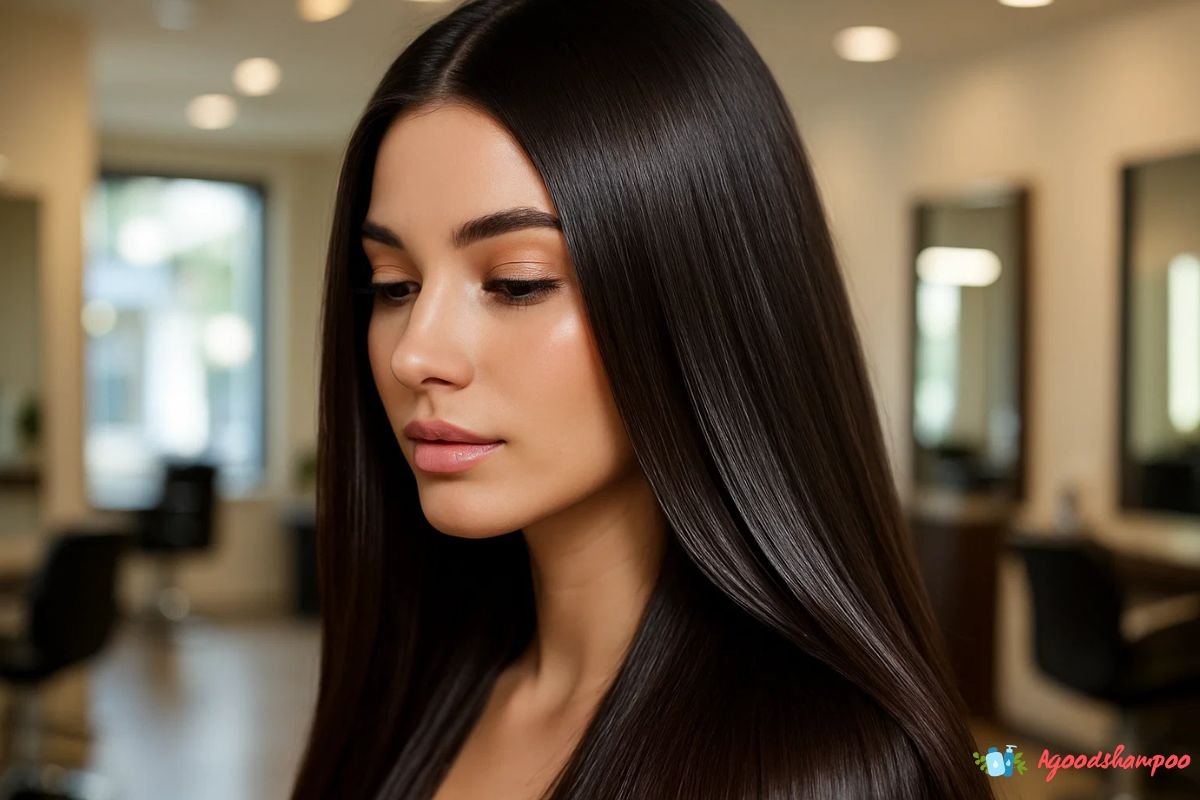Porcelain Hair Treatment: Glassy Shine or Glossy Gimmick
 Okay, so let’s start with the big question: what even is porcelain hair treatment?
Okay, so let’s start with the big question: what even is porcelain hair treatment?
If you’ve been scrolling through TikTok or watching salon reels lately, chances are you’ve seen sleek, reflective hair gliding through a flat iron like it belongs in a shampoo commercial. That’s porcelain treatment for you. It’s the kind of gloss and silkiness that makes people ask, “Is that even real hair?” and honestly, I get the appeal.
But here’s the thing: marketing makes it sound magical. I’m here to tell you what’s actually happening under the hood.
What Is Porcelain Treatment for Hair?
No, it doesn’t involve actual porcelain. Sorry. There are no crushed ceramic plates being rubbed into your strands.
Porcelain hair treatment is a high-gloss, semi-permanent smoothing system designed to repair damage, eliminate frizz, and make hair shinier than your future.
Think of it as a hybrid between keratin treatment and nanoplastia. It softens, seals, coats, and hydrates your hair using a mix of amino acids, silicones, plant-based oils, heat-activated polymers, and in some cases, formaldehyde-free smoothing agents.
The result? Sleek hair with reduced volume, high shine, and frizz that basically goes MIA.
Is It the Same As Keratin or Nanoplastia?
Not quite. But close. These treatments are like cousins they hang out in the same family but don’t wear the same outfits.
| Treatment Type | Core Ingredients | Straightening Power | Shine | Frizz Reduction | Formaldehyde? |
|---|---|---|---|---|---|
| Porcelain | Amino acids, silicones, oils, collagen | Medium (natural look) | High | Excellent | Usually none |
| Keratin | Hydrolyzed keratin, aldehydes | High | Medium | Very High | Often yes (unless labeled free) |
| Nanoplastia | Amino acids, glyoxylic acid | Medium-High | High | Excellent | No (but acidic) |
What makes porcelain different is its focus on shine and manageability without flattening hair completely. You still get movement. It’s the “rich-girl blowout” vibe without the poker-straight finish.
How Does It Work?
Let me geek out for a second here because this part is cool.
Porcelain treatments use heat-activated polymers that wrap around the hair shaft. These polymers bond temporarily to the cuticle layer, creating a smoothing shield. When flat ironed (usually at 230°C/446°F), this formula “locks in” to fill gaps, coat damage, and repel humidity.
Some formulas add hydrolyzed collagen or silk proteins, which can bind to your hair and mimic that soft, silky texture we all chase.
The best ones? They’ve got acid-balanced pH (around 4–5) to help reseal cuticles, reduce porosity, and prevent moisture loss. That means less breakage, fewer split ends, and better elasticity.
Porcelain Hair Treatment Reviews: What Real People Say
Let’s get real. Here’s the tea from actual users:
🧴 “My hair feels like glass. I can air dry and it still looks good.”
🧴 “It didn’t last the full 3 months, more like 6 weeks, but I’d do it again.”
🧴 “I’ve had keratin before this felt less harsh, and I didn’t have that chemical smell.”
🧴 “Game changer for Florida humidity. I actually went to the beach and didn’t puff up.”
However…
❗ “It looked amazing but weighed down my fine hair for a week.”
❗ “Not for curls unless you want to loosen them.”
That last one matters. While this isn’t a straightening system per se, it will relax curl patterns so 3A to 4C types, consider this before you dive in.
Is Porcelain Hair Treatment Safe?
Short answer? Yes when done right.
Most professional-grade porcelain treatments are formaldehyde-free, which is a big win compared to traditional Brazilian Blowouts. You’re not inhaling fumes, and your stylist doesn’t need a gas mask. But check the label some knock-offs might sneak aldehyde derivatives in the fine print.
Here’s what makes a porcelain treatment safe:
No formaldehyde or methylene glycol
pH-balanced (4–5 is sweet spot)
Fragrance-free or lightly scented
Done in a ventilated salon (still important)
For pregnant folks, super sensitive skin types, or anyone with asthma always consult a pro first. Even safe treatments can trigger reactions if you’re prone to allergies.
How Long Does Porcelain Treatment Last?
Realistically: 4 to 8 weeks.
Salon marketing will say 3 months. That’s if:
You’re not washing every day
You use sulfate-free shampoo
You avoid saltwater and chlorine
If you’re swimming weekly, using harsh cleansers, or doing hot yoga in a ponytail, expect the effects to fade faster.
But here’s the upside: the fade is gentle. Unlike keratin, you won’t see dramatic “before/after” drop-offs. Hair just gradually returns to normal.
Porcelain Hair Treatment at Home: Is DIY Worth It?
This is where things get tricky.
You can find DIY “porcelain” kits online especially on Amazon or TikTok shops. But here’s the truth: 90% of them are not true porcelain systems.
They’re usually deep conditioners or silicone-heavy masks labeled with fancy words like “glaze,” “mirror shine,” or “liquid keratin.”
Here’s how to spot a real one:
✔ Should require flat ironing at high heat (around 220–230°C)
✔ Instructions should say “do not wash immediately” (indicates bonding process)
✔ Ingredients like hydrolyzed proteins, amino acids, silicones, fatty acids
✘ No harsh alcohols or “fragrance” listed in top 5 ingredients
✘ No formaldehyde, DMDM hydantoin, or diazolidinyl urea
You can try a DIY version if you’re experienced, use heat safely, and go in with realistic expectations.
Is There a Homemade Porcelain Hair Treatment?
Sort of.
You won’t get the same bonding action without a lab-grade formula, but you can mimic the effects with a gloss-boosting mask like this:
Homemade “Porcelain-Style” Mask
2 tbsp hydrolyzed protein (or Greek yogurt as a soft alt)
1 tbsp argan oil or camellia seed oil
1 tbsp aloe vera gel
1 tsp apple cider vinegar
1 drop rosemary or peppermint oil (optional)
Blend, apply to damp hair, cover with a warm towel for 20 minutes. Rinse, then blow-dry smooth and use a heat protectant before flat ironing. Will it give you glass hair? Not quite. But it’s a decent shortcut for a soft, reflective finish.
Pros & Cons: Let’s Keep It Honest
Pros:
Glassy, mirror-shine finish
Great for frizz control
Doesn’t fry your hair like keratin can
Less chemical exposure
Still leaves movement (not pin-straight)
Looks amazing in photos
Cons:
Not ideal for very fine or thinning hair
Can slightly relax curls
Results are temporary (6–8 weeks average)
Salon prices range from $150–$350+
DIY versions are hit or miss
Final Thoughts: Is Porcelain Hair Treatment Worth It?
If you’re craving shine, manageability, and a bit of boujee smoothness, porcelain might be your new go-to.
It’s safer than old-school straightening systems, kinder to curls than keratin, and just overall more modern. But it’s not magic. You’ll still need to maintain it with sulfate-free shampoo, regular deep conditioning, and some heat care.
Think of it like lip gloss for your hair you look amazing, but it’s not forever.
Would I recommend it as a scientist? Yes, with the right formula and pro stylist.
Would I use it on color-treated or damaged hair? Only if the formula is protein-balanced and acid pH.
Would I call it the most successful treatment out there? No. But it might be the prettiest.

Michael Chen combines scientific expertise with hair care industry insights to offer well-researched product evaluations and tips for optimal hair health.